How to choose the best porridge and the right amount
Best oat & non-oat 'porridge': nutrition and product review
Are the days of plain oats for breakfast porridge numbered?
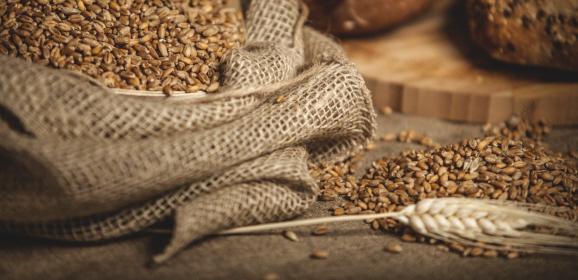
'porridge' grains under the spotlight
I explored more than 70 varieties of breakfast ‘porridge’ and this is what I found.
There are quick oats, instant oats, steel cut oats, traditional porridge, flavoured oats, oats in sachets, oats in cups, ancient grains, rolled rice, chia combos, semolina … variations on breakfast porridge.
I’ve dissected and compared their energy content, nutrient profiles and ingredient lists to save you time and effort in your quest to stay healthy and in top shape. These reviews form part of my background research for writing food and nutrition books.
Just to let you know. The interpretations and commentary are totally independent and free from bias. I have no association with any of the companies and brand names included in this investigation.
Find out how to decide which is the best 'porridge' choice for your body.
My brief 8 point summary:
- Short on time? Choose instant or quick 100% pure oats.
- More time up your sleeve? Choose old fashioned traditional 100% rolled oats.
- Like it sweet? Replace sugar, honey and syrups with fresh, dried or preserved fruit. Cook with low lactose cow’s milk for a subtly sweeter flavour.
- Break from sweet oats. Add nuts and seeds to change the flavour and texture.
- Tend to be heavy handed with added sugars at home? Choose portion controlled flavoured sachets but don’t add extra sweetness.
- Want a convenient fibre boost? Add oat bran or almond meal during cooking.
- Want a smooth protein boost? Add milk powder or almond meal during cooking.
- Not good at portion control? Either store a ⅓ cup scoop in the raw oat tub to measure the best serve size for you or use the portion controlled single serve sachets of porridge but understand that you may need more than one sachet because the serve size (and true amount of oats) in some packs is quite small.
For a detailed dissection, read on.
There is no need to get bogged down with brand names but I have included my top picks here for you.
If you have a head for number crunching, check out the detailed nutrient composition tables as well. It includes protein, fat, carbohydrate, sugars, fibre, sodium and ingredient lists. You don't need to look at that table because I have torn it apart and interpreted the numbers for you below.
1. Traditional rolled oats
Old fashioned oats are a blank (some say bland) breakfast foundation. Add a few extra ingredients to create a sweet, savoury or neutral dish that suits your body’s nutrient and energy needs.
Oats are versatile and usually cooked within in a few minutes. If you have the luxury of stacks of time for cooking and eating, consider steel cut oats. These take 20 minutes or more to cook and are chewier to eat.
Keep a ⅓ cup scoop in with the dry oats to better manage serve size and portion control.
The brand name doesn’t really matter. Unadulterated rolled oats are rich in fibre, low in natural sugar and low in sodium salt. The typical* composition of dry rolled oats is at the end of this article.
I use the nutritional value of 100% rolled oats as the benchmark or gold standard.
2. Quick or instant 100% pure oats
Quick or instant oats provide a similar blank breakfast foundation to rolled oats, only smoother, creamier and less chewy.
How big is a serve of oats?
Depends who you ask. Manufacturers use any weight they like to describe a single serve on their product label.
How much you and I serve at home is likely to be completely different to the size described on the label of bulk loose oats. I found the single serve for dry oats described ranged from 30 to 55 g.
I suggest ⅓ cup dry oats as a foundation serve.
When it comes to energy content, one slice of toast equals ⅓ cup of dry oats equals a couple of breakfast wheat biscuits equals a couple of boiled eggs equals a medium cavendish banana.
Adjust how many serves of oats you have to match the energy of your summer breakfast. If you have my book ‘this=that: a life-size photo guide to food serves’, you will find it easy.
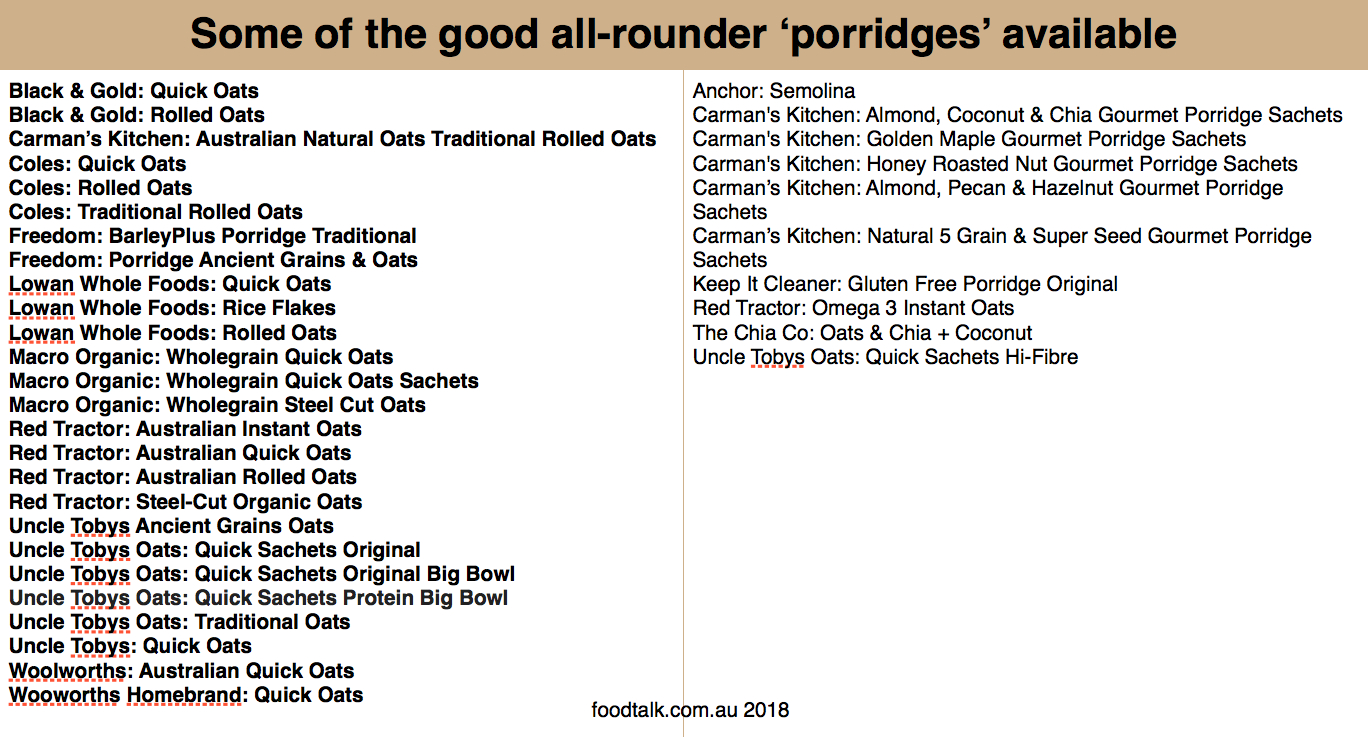
3. Single serve portion controlled sachets
Oats packed in portion controlled single serve sachets may be a good choice BUT is a single sachet right amount and quality for you?
When it comes to energy content, one single serve small sachet of oats with between 550 and 600 kJ per sachet equals about ⅓ cup of dry oats. Some sachets are a little larger with a higher energy content but don’t let the larger size put you off because chances are you really need to eat more than a single small sachet of oats for a satisfying breakfast.
- Jenny usually has a simple breakfast of two wheat/oat bix with milk and honey. She will find ⅓ cup dry oats cooked with milk as filling as the breakfast bix or she could choose a larger flavoured sachet and skip the added honey.
- Jim’s breakfast is closer to a couple of slices of toast spread lightly with peanut butter or avocado and topped with banana. One third cup dry oats cooked with milk will leave him hungry before mid morning. Jim is better to choose a bigger sachet (or double up the oats serve to ⅔ cup dry) and top the cooked oats with a tablespoon of nuts and fresh and dried fruit.
Single serve sachets are useful portion control tools especially if you are heavy handed with added sugars at the table or you prefer a flavoured or blended variety but don’t have time to create your own blend.
4. Flavoured oats: quick and traditional
4. Flavoured oats: quick and traditional
On the surface, it would seem that the average nutrient profile of flavoured sachets is not hugely different from plain traditional and quick oats. Flavoured products are subtly lower in protein and fibre content, subtly higher in energy and total carbohydrate, and higher in sodium and sugars.
It is only when you dig deeper and examine the detail and per single serve profiles that you really sort the wheat from the chaff (or should than be oats from the chaff?). The ranges are wide.
Some flavoured oats (and non-oat blends) contain 4 teaspoons table sugar in 100 g of product (adjusting for fruit sugars, nut sugars and milk powder sugars).
The good news is not all flavoured packs are sweetened with added sugars. Three out of 35 flavoured sachet products do not contain added sugars (in bold in the table below). Another two flavoured loose oat packs do not contain added sugars (in bold in the table below). For these products, the flavours comes from nuts, seeds, and/or grains other than oats.
A few other varieties that contain low amounts of added sugars (even though their name suggests a sweeter product) are included in the table.
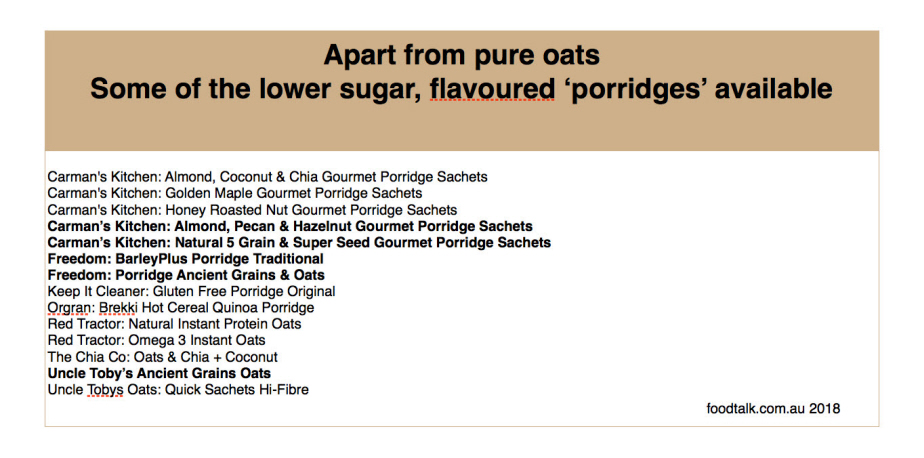
5. Pre-sweetened oats
The grain of pure 100% oats (traditional, quick or instant) contains less than 1 g sugar in every 100 g.
Flavoured instant quick oats contain as much as 24 g sugar (6 teaspoons) in every 100 g.
That’s like adding 2 to 3 teaspoons of sugar, honey or syrup to every ⅓ cup portion of dry oats cooked.
Where does the sweetness in commercial oats comes from?
Manufacturers don’t just add sugar and honey. They sneak in sweetness in the guise of many ingredient names: raw sugar, maple syrup powder, honey, honey powder, sugar, brown sugar, maltodextrin, dried honey, concentrated fruit puree, invert sugar, granulated sugar, coconut sugar, organic cane sugar, glucose, fruit pieces (dried fruit and sugar), golden syrup, and dried golden syrup. Sugars from milk powder and dried fruits add to the total sugars but I have accounted for these.
Flavour concentrates and extracts (coconut, vanilla, blueberry, rosemary) and spices (cinnamon and turmeric) compliment and enhance the sweeteners.
Is 24 g sugars per 100 g a problem?
It may not be if you add sugars at home to traditional pure oats. Ask yourself "what and how much sweetener you add at home to the porridge bowl?". A pre-sweetened flavoured porridge could help you cut back on added sugars if you are heavy handed with an ultra sweet tooth.
But not all pre-sweetened oats are loaded with sugars.
The amount of added sugars in six other flavoured sachets is not over the top: equal to a teaspoon or less added sugar per ⅓ cup oats present in the sachet (after adjusting for sugars from dried fruits, milk powder and nuts). These are included in the table of lower sugar ‘porridges’.
Some flavoured oats contain less sugar that 100% pure oats. How could that be? When nuts, seeds, coconut, chia, fibre or bran are added, these ‘dilute’ the total carbohydrate and sugar content.
You have the convenience of at least nine single-serve sachets flavours to choose from.
The flavoured oats with fewer added sugars and better nutrient profiles are highlighted in the table.
If these are not sweet enough for you, it is nutritionally best to tweak your cooked oats at home.
- Add fruit because you get a bonus of potassium and fibre: fresh, dried or preserved (can or plastic pack). Add sliced bananas or fresh figs at the very end of cooking. Cook in chopped dates, dried apple slices, sultanas, raisins or diced dried apricots, or sprinkle them on at the end.
- A pinch of cinnamon or drop of vanilla essence or coconut essence adds another flavour.
- Cook your oats with low lactose cow’s milk for a subtle sweetness that regular milk doesn’t provide.
- Still not sweet enough? If a little is not sweet enough for your tastebuds or you prefer to avoid concentrated added sugars with excess kJs but still want sweetness, add an intense sweetening agent such as aspartame or stevia with zero kJs.
Experiment and make your porridge savoury! Use stock to cook the oats. Stir in shredded precooked chicken and heat up or swirl in a beaten egg to cook through. Stir in leafy greens (e.g. spinach) just before serving. Season with cracked pepper. Saute onions, turmeric in a dash of oil until onion is transparent. This style of savoury porridge is called an oat congee.
6. Food intolerances?
Oats contain gluten so avoid oats if you have coeliac disease, gluten intolerance or gluten sensitivity in Australia. Swap to rolled rice, quinoa, chia or another grain combo labelled gluten free.
Rice is the foundation grain for the majority of gluten free ‘porridges’. Although the energy per 100g is similar to oat based porridges, the nutrient composition of rice porridges varies widely. With less protein, less fibre and lower natural B vitamin content, gluten free porridges are not as nutritious as oat porridge.
Gluten free ‘porridge’ offers zero advantage for weight management for those who are okay eating gluten.
Intolerances other than gluten? Spices, flavours, milk powder, preservatives, fodmap hazards, nuts, seeds, barley, wheat, herb extracts lurk in single-serve sachets and tubs of flavoured instant quick oats. The detailed nutrient composition table shows what is in the products (as of May 2018).
It is best to trust yourself to create a safe breakfast. Choose the blank foundational oats if you are okay with gluten. Cook with water. Add dairy or non-dairy ‘milk’ and other flavours that your body tolerates.
7. Salty surprises
Pure oats contain very little sodium salt. Between 2 and 6 mg in every 100 g.
It doesn’t matter whether the oats are steel cut, traditional, quick or instant.
If you are salt sensitive or have been advised to keep your sodium intake low for another health reason (e.g. to manage Meniers, high blood pressure, kidney problems, medication interaction, or to reduce risk of stroke), you will want to choose a low salt product.
Look for 100% or pure oats as the only item in the ingredient list if you need or want a truly low sodium porridge.
You don’t need to add salt when you cook oats at home.
Food technologists advise manufacturers to add sodium salt or other ingredients that contain sodium to ‘enhance’ the product’s cooking, texture, or flavour balance.
Some of the healthiest sounding oat products have enormous amounts of added sodium salt. Up to 134 mg sodium in every 100 g. Too high for a low salt eating plan.
But not all flavoured oats are loaded with salt. Eleven different flavoured oats or non-oat ‘porridges’ contain about the same amount of sodium salt as pure 100% oats, 6 mg or less sodium in every 100 g.
Want to explore more brand names and varieties? Check out the table for details and numbers.
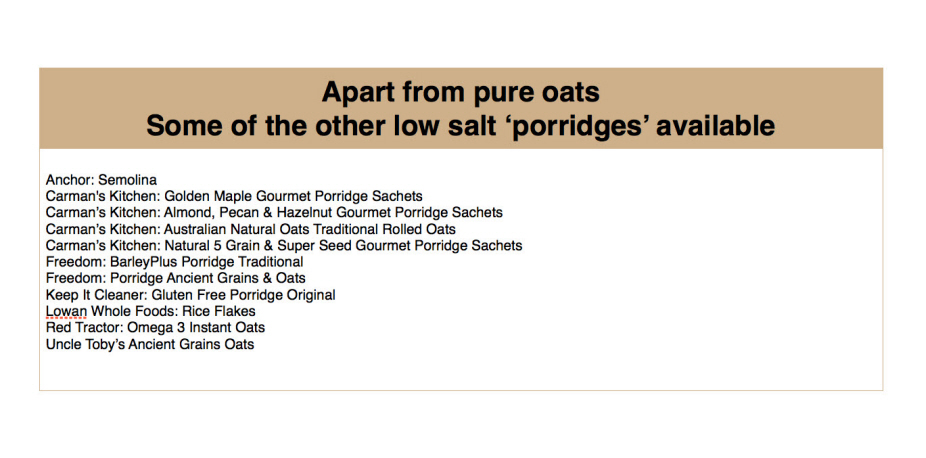
8. Fibre focus
Oats are popularly described as a ‘natural superfood’ and it is to do with the type of fibre they contain.
If you’ve ever left a half eaten bowl of porridge sitting around you will have noticed it congeals into a sticky and gluey blob. That’s goopiness is partly due to the fibre.
Pure oats do help improve blood cholesterol levels by lowering cholesterol reabsorption (as part of a healthy diet low in saturated fat. 3 g beta-glucan a day is required to help lower cholesterol. A serve contains 1.6g beta-glucan.
There’s no advantage of steel cut over traditional oats for beta-glucan but there is a difference in taste, texture, and cooking times.
Pure oats contain on average close to 11 g fibre in every 100 g. Cutting, rolling, pre-cooking or pulverising the grain to make instant or quick oats does not change the amount of fibre present. Pure 100% quick and instant oats contain about the same amount of fibre. Think of the fibre as pre-chewed. What makes a difference to the fibre content of oats is the quality of oats selected by the manufacturer and whether fibre is removed during processing.
For a creamy fibre boost, I simply add one tablespoon of oat bran to ⅓ cup dry oats. Oat bran is a simple and economical nutrient booster that adds body to porridge. It is an excellent way to boost the fibre of flavoured single serve portioned sachets.
Every tablespoon of oat bran adds 1 g fibre. It stirs in and cooks through quickly.
The fibre content of flavoured instant oats ranges from 5 through to 14 g fibre in every 100 g. Fibre additives include psyllium, rice bran, nuts, seeds, fibre, dried fruit chickory root fibre, linseed fibre.
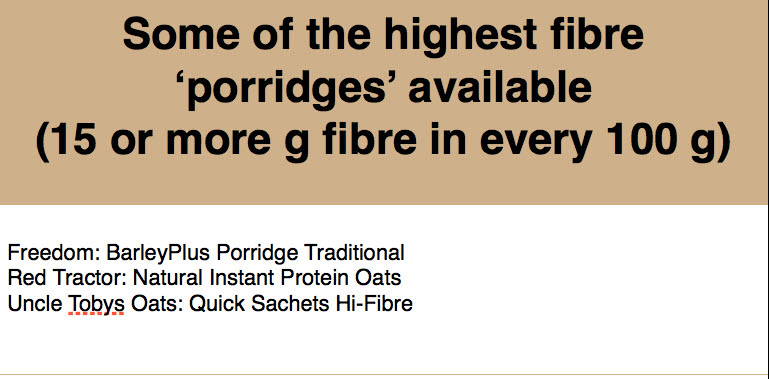
9. Protein boosters
On average, pure oats (steel cut, traditional, quick and instant) contain about 13 g protein in every 100 g. Oats are not a naturally high protein food but new cultivars with a higher protein content are entering the market.
To boost the protein of breakfast oats, cook with dairy milk (cow or goat) rather than water.
These extra items add another two to three grams protein per tablespoon:
- skim milk powder (during cooking)
- evaporated skim milk (during cooking)
- almond meal (during or at end of cooking)
- nuts and seeds (during or at end of cooking)
10. Weight management
The majority of oats and non-oat ‘porridges’ use weight to describe serve size or portion to serve.
I found 11 different serve sizes declared on oat labels, ranging from 30 to 55 g for dry oats and 170 g for ready-to-eat tubs. Be on the look out for tricky labels that list a smaller ‘per serve’ weight. By cunningly using a smaller serve size than other products on the shelf, you’ll think the product has fewer kJs. You’re not comparing like with like.
Do you use a kitchen scale to measure out your dry oats or check portion size? Most people don’t. A cup or scoop is more common. That’s why I show serves in bowls and describe them in cups in my this=that books.
With this variation in declared serve sizes on food labels, it is hard for you to make a meaningful quick product choice in the supermarket based on a ‘per serve’ size unless the serves are set as portion controlled pre-packed sachets.
Single serve sachets, tubs and bowls for a healthier body?
Single serve sachets are useful portion control tools especially if you are heavy handed with added sugars when you make up oats in bulk or you prefer flavour variety but don’t have time to create your own blend. BUT single serve sachets tend to be small and they will leave you feeling hungry by mid morning if you are used to eating a more substantial breakfast.
Make portion control easier by leaving a ⅓ cup scoop in your oat container. Because you don’t have to hunt in the kitchen drawer for the measuring scoop, it is faster to get the right serve size for you.
In the big scheme of things, small sachets contained fewer kilojoules (kJ) than big sachets. Nothing tricky about that.
Sachets with added nuts and seeds or claims for omega 3 contained more kJ per serve. Is this a bad thing? No. A single sachet of oats is a fairly light breakfast. Extra nuts and seeds make for a longer-lasting heartier start to the day. A single sachet or ⅓ cup dry oats may not be enough for you.
If you just go by kilojoules per serve as described on the label, you could become unstuck and eliminate brands and flavour varieties that fit perfectly with your health and body weight goals, if you adjust the serve or portion.
If you prefer loose packed oats, use ⅓ cup as the serving guide.
Want even more detail?
If you are a number cruncher, discover the detailed nutrient profiles and ingredient lists (collated May 2018) for oat and non-oat grain porridges. There are a few gaps in my data because some suppliers have not replied to me yet. When they finally do, I will update the data for you.
And just to let you know, this article is free from bias and influence. I am not associated with nor have ever received samples from any of the companies listed.
This entire piece of research boils down to a few simple key messages:
- Choose a plain foundation 100% oat (rolled, instant or quick) and add your own flavours at home.
- Use multiples of ⅓ cup to personalise and measure your serve size.
- Don’t add extra sugars to portion controlled flavoured sachets. They are usually sweet enough.
- If you want extra sweetness, add fruit to the bowl.
- If you need more fibre, add oat bran, almond meal or mixed nuts.
